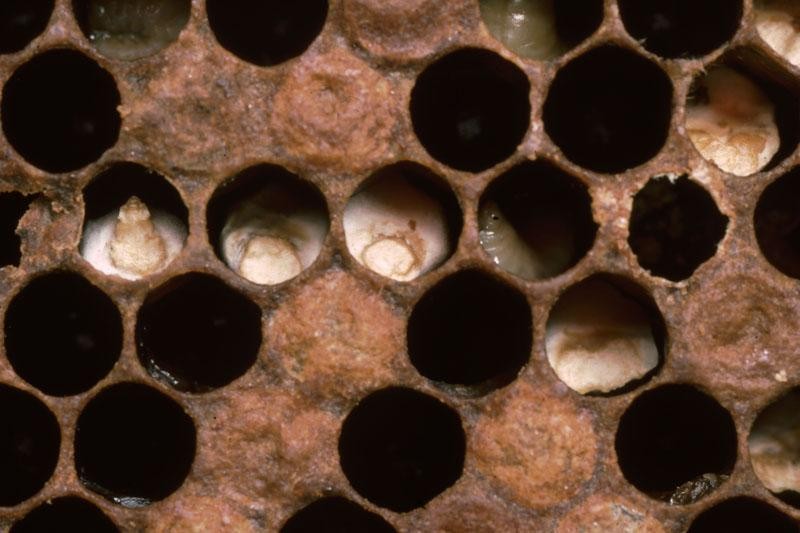Honeybee Diseases - Chalk Brood
Chalk Brood - is a fairly common disease of honeybee brood and is caused by a fungus Ascosphaera apis. The fungus grows through the bodies of infected larvae sending fine vegetative thread-like growths into the larval body tissues, eventually overcoming and killing the larvae after its cell have been sealed. The disease spreads as the bodies of dead larvae release sticky spores which adhere to hive components and adult bees. These spores are known to remain dormant and infectious for up to 3 years or more. It is not regarded as a serious disease in normal circumstances, its effects on the colony being only slight. It is generally present in the majority of colonies at some point in time and can be present in its spore stage without affecting the colony.
Download the Chalk Brood Info Sheet to obtain a printable version of Chalk Brood information, detection and treatment methods for your records.
Recognition
Image Courtesy The Animal and Plant Health Agency (APHA), © Crown Copyright

Chalk Brood infection
The infected larvae take on the hexagonal shape of the cell before shrinking, at which point the adult bees will remove them from the comb. Remains are noticeable on the hive floor or at the hive entrance, looking as though they had been mummified. The dead larvae which are hard and coloured chalky white are generally removed by adult bees after they have torn down the cell cappings. These 'mummies' will be quite noticeable on the hive floor or at the hive entrance
Detection
Hive Examination - Examination of brood frames and floor debris is required especially in spring. Bees should be gently shaken from the frames to allow full inspection, abnormalities are then easily spotted. Chalk brood 'mummies' are easily seen and may even fall out of the cells during examination.
Monitoring - Vigilance is important with all honeybee diseases. Check all apiaries and colonies regularly for health and suspect any colonies that are not thriving where there is no already known reason. Colonies that are not performing well or die out should be examined thoroughly and sealed to prevent robbing and spread of any disease present.
Treatment
Chalk brood is generally present in the majority of honeybee colonies at one time or another. The spores of Ascosphaera apis can be present in a hive and have no apparent effect on it. It is not generally considered a serious disease and the effects on colonies are only slight. There is no specific treatment recommended for Chalk brood. The disease has only slight effect on healthy colonies but may have a more serious effect on weakened colonies. Prevention is the best method of controlling this disease by maintaining healthy, strong and vigorous colonies that display good hygienic traits. Good husbandry contributes greatly to overall colony behaviour and health, thereby avoiding the conditions in which Chalk brood can flourish. Colonies that suffer excessively from Chalk brood may need to be re-queened. Disease prevention is best practice, maintain good apiary housekeeping:
- Always maintain strong and vigorous colonies that show good hygienic tendencies, re-queen from known chalk brood-free colonies.
- Always maintain a high level of hygiene in all your beekeeping practices
- Carry out methodical health inspections on a regular basis, checking for brood disease particularly in spring and autumn.
- Never transfer combs between colonies without checking for brood diseases
- Systematically replace old brood combs in your hives melting down the old comb to maintain clean and healthy brood.
- Never bring colonies or equipment into your apiary without establishing their origin, condition, and disease status.
- Sterilise any secondhand equipment or hive components before introducing them into your apiary
- Discourage drifting and robbing in the apiary
- Suspect stray swarm health until you know otherwise
- Report any incidence of disease or suspicious conditions immediately to your local association
Vectors
Millions of Chalk brood fungi spores are released from dead larvae, and they can exist and remain infectious for a long time. They are sticky and will attach to hive components, equipment and adult bees.
- Beekeepers - Transferring contaminated equipment / material between hives, colonies and apiary sites.
- Robbing - Colonies weakened by Chalk brood will fall prey to robbing, transferring spores to other colonies and apiaries.
- Drifting - As with Robbing will transfer spores to other colonies.
- Swarming - Swarms can carry the spores with them to new sites where the disease can spread once new brood is produced.
Try the Honeybee Diseases Quiz
About the 'My Beekeeping Kit' website.
Contact Iain Dewar for enquiries, suggestions, corrections and contributions for improving the notes. Always welcome!